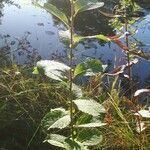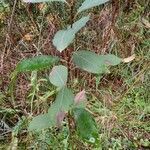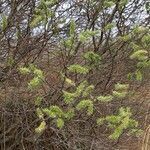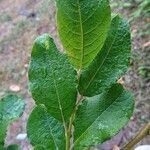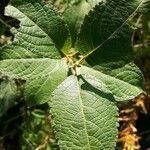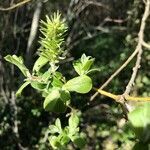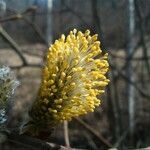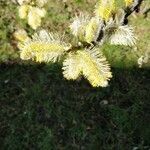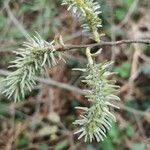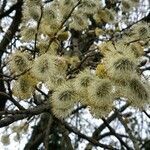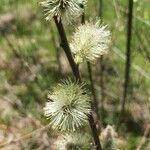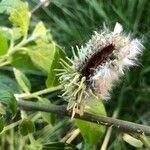Shrubs or small trees. Branchlets yellowish green to yellowish red, pilose or glabrous. Stipules semiorbicular, apex acute; petiole ca. 1 cm; leaf blade ovate-oblong, broadly ovate to obovate-oblong 5-7 × 2.5-4 cm, slightly thick, abaxially tomentose or downy, adaxially dull green, wrinkled, more conspicuously so when fresh, glabrous, base rounded, margin irregularly notched, dentate, or subentire, usually slightly recurved, apex acute or apiculate, usually contorted; reticulate veins conspicuous abaxially. Flowering precocious. Male catkin ellipsoid or broadly ellipsoid, 1.5-2.5 × ca. 1.5 cm, sessile; bracts 2-colored, light proximally, black distally, lanceolate, ca. 2 mm, long pubescent. Male flower: gland adaxial; stamens 2, distinct; filaments 6-8 mm, slender; anthers yellow, oblong. Female catkin shortly cylindric, ca. 2 × 0.8-1 cm, to 6 × 1.8 cm in fruit, shortly pedunculate; bracts as in male catkin. Female flower: gland as in male flowers; ovary narrowly conical, 2.5-3 mm, downy; stipe ca. 2 mm; style short; stigma 2-4-lobed. Capsule to 9 mm. Fl. Apr, fr. May-Jun. 2n = 38.
Bushy, deciduous shrub to small tree, 3-6 m high. Leaves lanceolate to elliptic or obovate, 70-120 mm long, dark green above, grey and felted below, dull yellow in winter. Inflorescences: male catkins plump and silky, 25-50 mm long, freely produced on felty greyish stems before leaf-set. Gynoecia hairy. Flowering time early spring.
A European sp. with obovate to suborbicular lvs 5–13 × 2.5–5.5(–8) cm, apiculate to shortly acute, ± crenate-serrate and tomentose, with irregularly revolute margins, otherwise much like no. 23 [Salix discolor Muhl.], furnishes the pussy-willows of florists for Easter-decorations. It occasionally escapes about nurseries.
A shrub or small tree. It grows 7.5-9 m tall and spreads 6-7.5 m wide. The leaves are alternate and have short points. There are small teeth around the edge. The leaves are 1-3 times as long as wide. Male and female catkins grow on separate trees. The female has silver catkins and the male has large yellow catkins.
